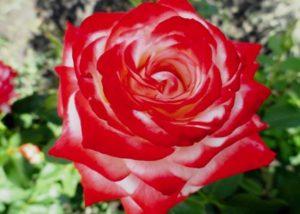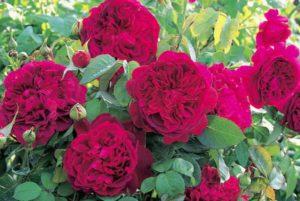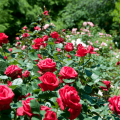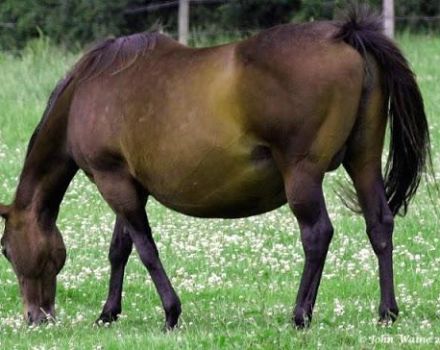Description of varieties of standard roses, planting and care in the open field
Standard bouquet roses are not a separate type of plant, but just tricks of flower growers to decorate and modify their flower beds. This growing technique allows you to get a lively bouquet of roses in your garden. Standard trees fit perfectly into the landscape, as an independent plant, as well as in a group with other shrub roses. What varieties can be grown in this way, how to achieve such beauty, we analyze below.
Basic description
The rose got its name because of the long trunk, on which shoots and branches are completely absent, but there is a crown in the form of a cap with many flowers and leaves. An elongated section of the trunk is called a stem.
The advantages of the standard beauties are:
- The plant is highly resistant to cold and drought.
- They have a long flowering period compared to conventional varieties.
- Due to its height, the crown receives more sunlight.
- Due to the long trunk and lack of foliage near the ground, roses are less damaged by diseases and pests.
- Takes up little space in the flower bed.
The disadvantage is a kind of crown trimming to maintain this look. Certain skills and abilities are required here.
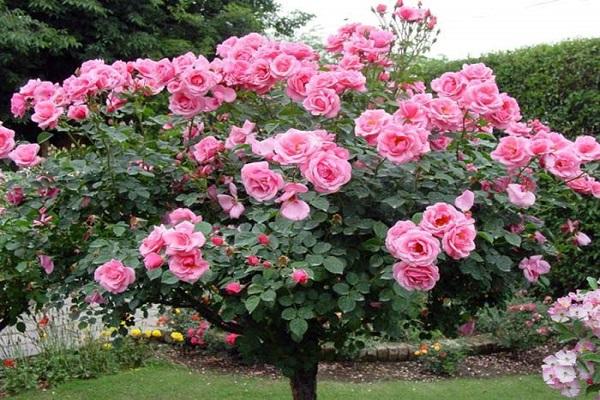
A tree rose is obtained by grafting an ordinary rose onto a rose hip. Therefore, the height of the resulting plant cannot exceed 1.5 meters. The main condition for the successful receipt of a standard beauty is the cultivation of a stock on a rosehip.
Such a rose has a slightly different structure than cultural ones. It has a root system, a long trunk (stem) and a crown. The branches of the crown can be erect (when the graft is from cultivated varieties) or flowing (when the graft is from a climbing rose).
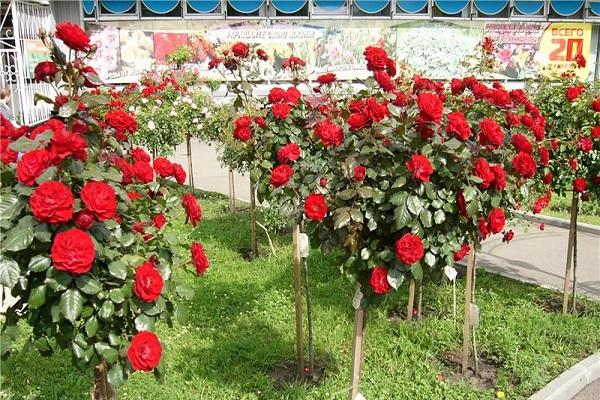
Variety of varieties and varieties of standard roses
There is a classification of standard roses depending on height and size:
- miniature - plant height - up to 0.5 meters, the scion are compact miniature varieties that do not take up much space in the garden;
- half-stems - height - 60-70 centimeters, floribunda roses, characterized by abundant flowering, serve as a scion;
- classic - height - 90-110 centimeters, scion - tea hybrids, with especially delicate flowers of various colors;
- weeping - they grow up to 1.7 meters, ground cover and liana-shaped or climbing roses with very long shoots are used as a scion, due to which the stem is very high.
The rating of the best pink varieties is made up of hybrids or varieties of rose bushes used for scion on a stem. Here we will talk about them.
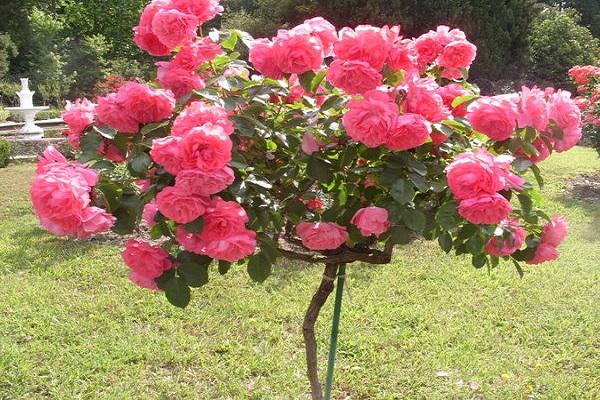
Knirps
This rose is used for small areas. The flowers of the Knirps variety are lush, double, deep pink in color, look great against the background of dark green foliage with a carved edge. The plant adapts well to harsh climatic conditions. Incessant rain, severe frosts, temperature drops, summer heat - everything does not care about the Knierps rose. The only problem may be a strong wind, which ruffles a beautiful crown.
View - ground cover, stem height - 70-120 centimeters. The size of the flower is 3-4 centimeters in diameter. Flowering lasts from June to October.
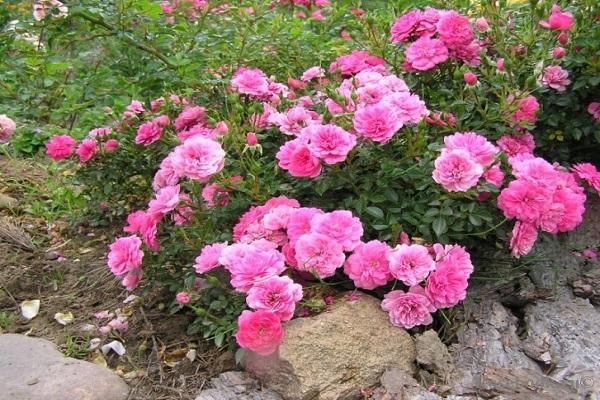
Claude Monet
The trunk height is 70-120 centimeters. The flower diameter is 8-9 centimeters. Flowering is long, abundant, lasting from June to late September.
Throughout the season, Claude Monet plays with shades of the color palette. After blooming, the buds are orange with red spots, and towards the end of flowering they become pale pink, with beige veins. The rose is disease resistant, but may feel unwell in heavy rain. Its buds lose their gloss, become disheveled, and may rot.
Leonardo da Vinci
Perhaps the most unpretentious variety of roses. He is not afraid of cold, rain and heat. It is resistant to any disease and pest. The best place in the garden would be an area protected from drafts and winds.
The flowers are huge, with a diameter ranging from 8 to 10 centimeters. Lush, densely filled with petals, the flowers are bright pink in color, and the buds are red. Each flower blooms for about three weeks, then quickly dries up and sprinkles, while not losing its color. The height of the trunk is 70-80 centimeters, blooms from July to September.
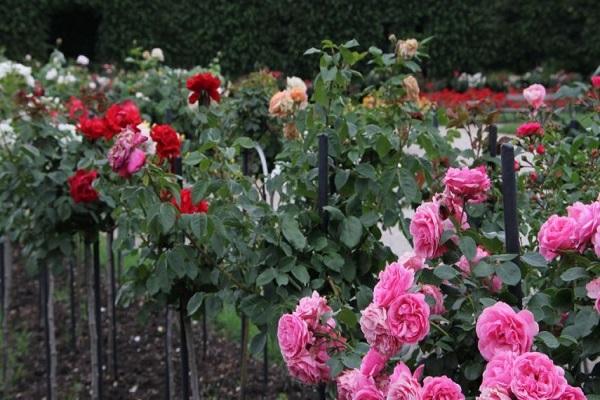
New Dawn
A standard rose with a scion of a climbing rose of the New Dawn variety is a vigorous plant. The height of the trunk reaches 100-250 centimeters. It is resistant to temperatures of -30 degrees, but is exposed to powdery mildew. The timely prevention of the virus can save the plant.
It can be grown both in illuminated areas and in partial shade. The flower is very large, up to 10 centimeters, creamy pink color, with shades of silver. It decorates well the walls of a house or a hedge, but it looks no worse as an independent plant.
Paul Noel
The type of variety is climbing. A standard rose with such a scion has very long flowing shoots. Thanks to such features, Paul Noel's standard rose is used for planting around arbors, arched compositions.
The flowers have a coral shade, they are densely filled with petals, lush and not very large, up to 5 centimeters. The height of the stem reaches a limit of 250 centimeters, but they are also found with a shorter stem, about 1 meter.

Super Excelsa
The plant can be grown in Central Russia, as it can withstand the most unpleasant incidents of nature. Resistant to spotting, but affected by powdery mildew. The height of the climbing rose Super Excels is up to 2.5 meters.
The flowers are medium, up to 5 centimeters, with a bright crimson color with whitish veins. These stripes are not visible under the scorching sun. The flowers do not grow singly, but are collected in large inflorescences of five to six specimens. The scourge of a standard rose will perfectly decorate the walls of your house or a hedge.
Schneewittchen
In Russia, the rose is called Snow White, for its pure white flowers. The crown of a tree-like rose of this variety is densely covered with large inflorescences, which makes it resemble a flying cloud.The height of the plant together with the stem is 70-120 centimeters. Flowering lasts from June to October. The species is floribunda. The size of the flowers is up to 6 centimeters.

Landing features
Before planting, it is important to decide in what way you want to get a beauty: to plant or buy a ready-made seedling. Today it will not be difficult to find a seedling on sale - of any variety, of any color. You just need to choose the right seedling so that you are not deceived, and then plant it on the site.
Seedling selection rules
There are few of them; what you should pay attention to:
- Standard rose seedlings are usually sold rooted in containers.
- The crown is well developed and has strong shoots.
- The stem or trunk is even, with a formed bark, its diameter must be at least 1 centimeter.
- The leaves are juicy, not yellowed and without spots.
- Root neck without signs of disease.
The seller must be consulted on the subject of the variety, type, in order to further determine the care of the rose.
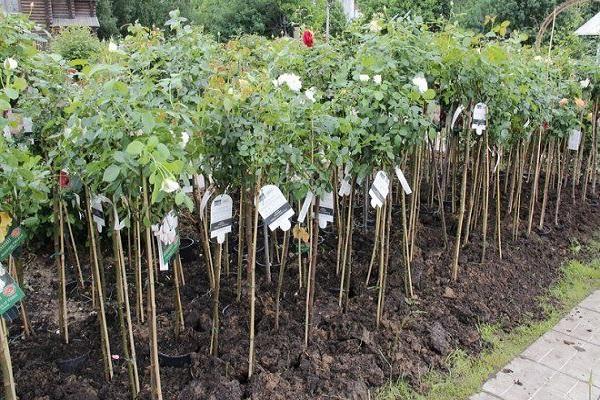
Choosing the right place
Attention to the standard rose should be paid more than a simple one. A plot in the garden for her needs to be selected sunny, but without scorching sun rays and away from the prevailing winds.
Optimal timing
The best dates are for planting a standard rose seedling: late April-early May. But during the summer, planting young trees is not prohibited, until September, so that the root system has time to take root.
Site preparation
Many varieties of standard roses tolerate any soil, since their base is not a rose, but a stock. But the best are light loamy soils, into which organic matter, compost and sand can subsequently be added. If there is little space on the site, and you have to plant in the old place, then the top layer is removed about 70 centimeters and a fresh one is poured.
The soil is dug to a depth of 50-70 centimeters so that it becomes airy and light. The reaction of the soil should be either neutral or slightly acidified (5.5-6.5). The pit is dug quite spacious, since the root system must be neatly laid out around its perimeter.
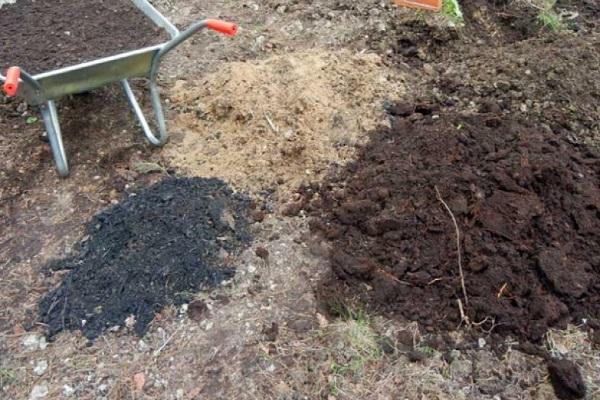
Optimal scheme
When determining the distance between neighbors, the size of the crown should be taken into account; it should be about 1 meter, no less.
Landing technology
Step-by-step technology for planting a standard rose:
- Take a strong stake and treat its end with an antiseptic to a depth of incorporation into the soil, at least 50 centimeters.
- When installed, it should not exceed the height of the crown.
- It is placed on the side of the prevailing wind so that the tree does not sway.
- The root system of the stem is lowered into the hole and the root is spread. The seedling should be located slightly inclined to the stake from the opposite side.
- The roots are covered with earth and compacted.
- The stem is tied with soft threads in several places, and in order not to cut the bark, the trunk is wrapped with soft material under the threads.
- Half of the root collar is buried in the hole.
Humus, sand and peat can be poured at the bottom of the hole so that the plant receives nutrients during regrowth.
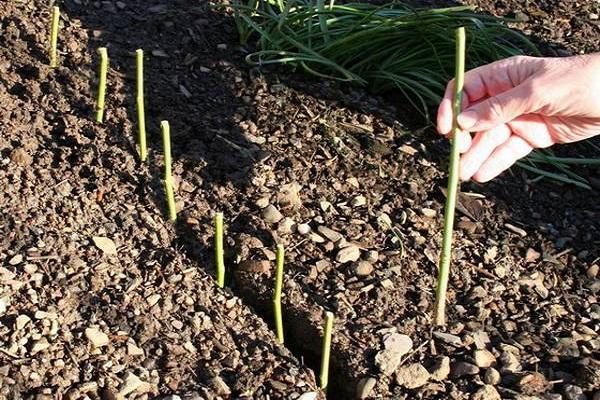
The nuances of caring for roses
A feature of care is the conservation of the crown from drying out at the moment while the seedling takes root. For this, the place of the scion is covered with wet moss or cotton wool, and wrapped on top with protective material. It is important to keep the substrate constantly moist. The wrapper is removed when the buds appear and swell. Further care consists in the timely implementation of watering, loosening, weeding and feeding the standard rose.
Watering
Watering should be regular, as the soil under the tree dries out. The rose is irrigated in the morning, before the sun is fully formed, or in the evening, after its sunset. Water, in large quantities, is poured under the root. So that moisture evaporates less from the near-trunk area, the earth is sprinkled with mulch (peat, humus, needles).Each time, the crown is irrigated with a spray can to provide it with water procedures and wash off the dust.

Weeding and loosening
Weeding is carried out as the area under the rose becomes clogged. If the weeds are large, then manual weeding is required, small grass can be cut down with a hoe. Loosening at the same time. This agrotechnical technique will provide the root system with additional oxygen.
Garter to support
It is important to install the support even during planting of the seedling. But as the stem grows, it should be changed every time, setting a larger one in height. The support should be straight, not bend. The plant is tied to it in several places - so that it does not stagger.
The support must be very strong as the plant grows large and heavy. As a support, you can take metal pipes, wooden colas, store (plastic).
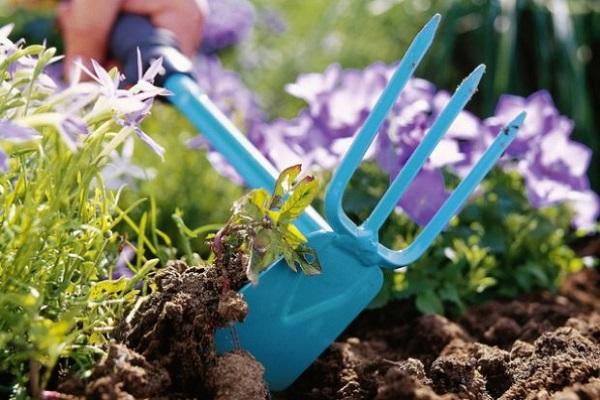
Top dressing
During the season, the standard rose is fed several times.
- In the spring, after pruning, they are fed with mineral fertilizers together with organic matter. Any complex of minerals with a high percentage of nitrogen is suitable here. Humus is taken as organic matter. They are applied at the root by watering or in bulk, followed by incorporation into the soil.
- After the first flowering, a complex of mineral fertilizers is applied.
- After the second color, they are fed with mullein infusion and minerals.
- At the end of summer, closer to September, you can apply phosphorus-potassium fertilizers.
In addition to root dressing, the rose is provided with regular foliar spraying with Kemira Lux and Solution solutions. These are complexes containing nitrogen, potassium, phosphorus, as well as a set of minerals: boron, manganese, magnesium, zinc, iron. The concentration of the substance is optimal in the proportion of 1 gram per 1 liter of water. During flowering, spray in the morning and evening, until the dew has dried, and when it has just gone to bed.
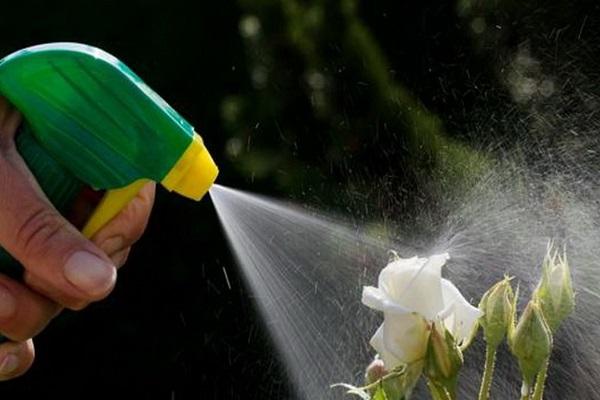
Pruning
With the help of pruning, a crown is formed. Hybrid tea varieties and floribundas are pruned, leaving about five buds on the shoots. In climbing trees, last year's branches are removed, while the young ones are slightly shortened. When there are no replacement branches, last year's shoots are only pruned.
Pruning standard roses for winter and spring is carried out with a sharp tool, at a right angle, retreating 1 centimeter from the bud. If the shoot is very thick, then take a file or a lopper. Slices are covered with brilliant green or garden pitch.
Wintering
In the last decade of October, they begin to shelter standard roses. Before this, the crown is cut: the young shoots are removed completely, and the remaining branches are shortened to 40 centimeters. All the foliage is also cut off so that it does not become moldy during storage.
Having collected the branches of the crown in a bunch, they are wrapped with a covering material and tied with a rope. If the plant is short, then it is covered in a tilted state. To do this, on one side, they dig a trench under the stem and bend over the tree. Spruce branches are laid under the crown, then another layer of shelter is placed on top.
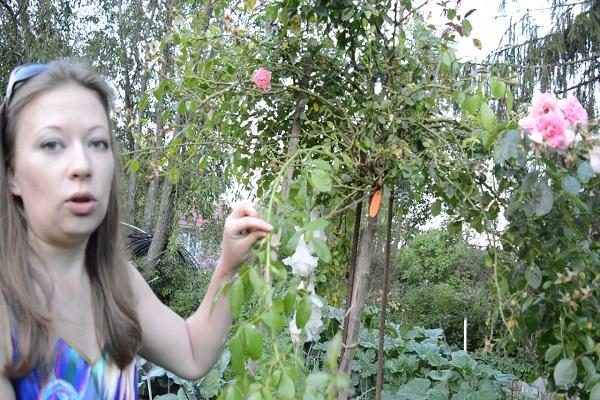
Protection against diseases and pests
Standard rose can be affected by the following diseases:
- rust;
- purple and black spotting;
- gray rot of buds;
- powdery mildew;
- cercosporosis of leaves.
To overcome ailments, it is necessary to treat the trees with fungicide solutions. From pests on roses, spider mites, thrips, aphids can start, which can be defeated with the help of Actellik, Inta-Vira, Fitoverm and other insecticides for flower crops.

Breeding flowers
Self-cultivation of standard bushes is an interesting and exciting business. The field of work here is very wide. On one rootstock, you can arrange a bouquet of several roses of different colors.
It is not so difficult to grow a rose on a stem, it is enough to have a high-quality stock. A three-year-old rosehip is taken as a stock, the height of the main shoot should be about 1.5 meters. The beauty of a rose grafted onto it depends on how you prepare a single-stemmed rose hip. Further work is carried out in the direction of the usual grafting of cuttings.
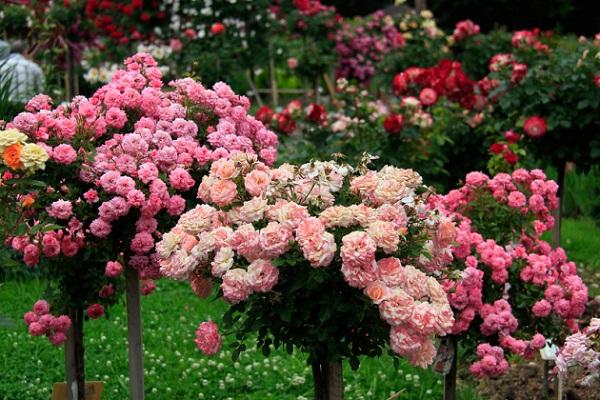
Combination with other plants
Firstly, the gorgeous bouquets of standard roses look great against the background of the lush greenery of the lawn or the sky. Secondly, they fit perfectly into any corner of the garden and on any flower bed. It is customary to plant this type of roses next to the following flowers:
- weeping willow;
- monard;
- green undersized shrubs;
- flowering ornamental bushes.
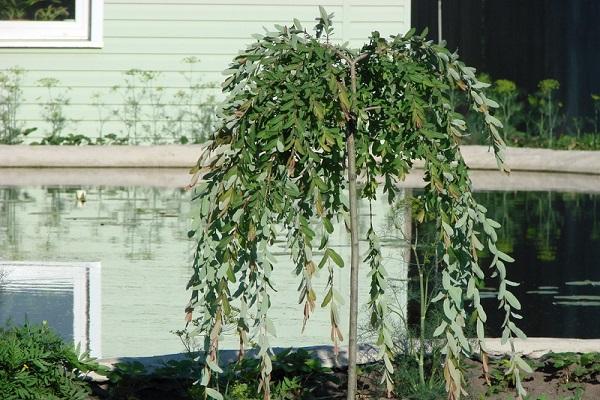
Erect flowers of smaller sizes can be planted under the crown: asters, marigolds, gladioli. You can play with the colors of the roses themselves, mixing white with orange, red with cream. This is where your fantasy should work.
By purchasing and growing a standard rose, you get an unforgettable beauty that will attract any passer-by. These plants take root well in any conditions. They can be grown both in the open field and in the house - as an indoor "pet".
